Quantitative Investigation of Fracture Apertures during Temporary Plugging and Diverting Fracturing
Abstract
:1. Introduction
2. Mathematical Equations
2.1. Rock Deformation
2.2. Fluid Flow in Porous Media
2.3. Fluid Flow within Fractures
2.4. Fracture Initiation Law
2.5. Fracture Propagation Law
3. Model Establishment and Simulation Methods
3.1. Model Establishment
3.2. The Propping Effect of the Proppant
3.3. The Plugging Effect of the Tight Plug
3.4. Model Input Parameters
4. Simulation Results
4.1. The Permeability of the Tight Plug
4.2. The Length of the Tight Plug
4.3. Young’s Modulus
4.4. Rock Tensile Strength
4.5. In Situ Stress Contrast
4.6. The Leak-Off Coefficient of the Fracture Surface
4.7. Fluid Injection Rate
5. Discussion
5.1. Multi-Parameter Comparative Analysis
5.2. The Risk of Screenout
6. Conclusions
- (1)
- The aperture at the initial or the diversion fracture mouth has a positive correlation with the rock tensile strength and the fluid injection rate. It has a negative correlation with Young’s modulus and the leak-off coefficient.
- (2)
- The aperture at the initial fracture mouth increases with the length of the tight plug and decreases with the permeability of the tight plug. The aperture at the diversion fracture mouth decreases with the length of the tight plug and increases with the permeability of the tight plug.
- (3)
- Screenout tends to occur at the mouth of the diversion fracture. Moreover, factors influencing the aperture at the diversion fracture mouth can be sorted by sensitivity as follows (strong to weak): Young’s modulus, rock tensile strength, fluid injection rate, the length of the tight plug, the permeability of the tight plug, the leak-off coefficient, and in situ stress contrast.
- (4)
- Reservoirs with low Young’s modulus values and high rock tensile strength generate wide initial and diversion fractures, ensuring safe proppant transportation at the fracture mouth. Moreover, increasing the fluid injection rate can effectively enlarge the fracture aperture and ensure safe construction.
Author Contributions
Funding
Conflicts of Interest
References
- Tong, X.; Zhang, G.; Wang, Z.; Wen, Z.; Tian, Z.; Wang, H.; Ma, F.; Wu, Y. Distribution and potential of global oil and gas resources. Pet. Explor. Dev. 2018, 45, 779–789. [Google Scholar] [CrossRef]
- Isaac, O.; Hui, P.; Oni, B.; Samson, F.A. Surfactants employed in conventional and unconventional reservoirs for enhanced oil recovery—A review. Energy Rep. 2022, 8, 2806–2830. [Google Scholar] [CrossRef]
- Chen, B.; Barboza, B.; Sun, Y.; Bai, J.; Thomas, H.R.; Dutko, M.; Cottrell, M.; Li, C. A review of hydraulic fracturing simulation. Arch. Comput. Methods Eng. 2021, 29, 1–58. [Google Scholar] [CrossRef]
- Zhou, H.; Wu, X.; Song, Z.; Zheng, B.; Zhang, K. A review on mechanism and adaptive materials of temporary plugging agent for chemical diverting fracturing. J. Pet. Sci. Eng. 2022, 212, 110256. [Google Scholar] [CrossRef]
- Wang, D.; Zhou, F.; Ge, H.; Shi, Y.; Yi, X.; Xiong, C.; Liu, X.; Wu, Y.; Li, Y. An experimental study on the mechanism of degradable fiber-assisted diverting fracturing and its influencing factors. J. Nat. Gas Sci. Eng. 2015, 27, 260–273. [Google Scholar] [CrossRef]
- Sneddon, I.N.; Elliot, H.A. The opening of a Griffith crack under internal pressure. Q. Appl. Math. 1946, 4, 262–267. [Google Scholar] [CrossRef]
- Perkins, T.; Kern, L.R. Widths of hydraulic fractures. J. Pet. Technol. 1961, 13, 937–949. [Google Scholar] [CrossRef]
- Palmer, I.; Carroll, H.B. Three-dimensional hydraulic fracture propagation in the presence of stress variations. Soc. Pet. Eng. J. 1983, 23, 870–878. [Google Scholar] [CrossRef]
- Morales, R. Microcomputer analysis of hydraulic fracture behavior with a pseudo-three-dimensional simulator. SPE Prod. Eng. 1989, 4, 69–74. [Google Scholar] [CrossRef]
- Todd, B.; Choudhary, Y.; Bhamidipati, S. Fracture-width estimation for an arbitrary pressure distribution in porous media. In Brasil Offshore; OnePetro: Richardson, TX, USA, 2011. [Google Scholar]
- Guo, Q.; Feng, Y.Z.; Jin, Z. Fracture aperture for wellbore strengthening applications. In Proceedings of the ARMA US Rock Mechanics/Geomechanics Symposium, San Francisco, CA, USA, 26–29 June 2011; ARMA: Lee’s Summit, MO, USA, 2011; p. ARMA-11. [Google Scholar]
- Shahri, M.; Oar, T.; Safari, R.; Karimi, M.; Mutlu, U. Advanced geomechanical analysis of wellbore strengthening for depleted reservoir drilling applications. In Proceedings of the SPE/IADC Drilling Conference and Exhibition, Fort Worth, TX, USA, 4–6 March 2014; SPE: Richardson, TX, USA, 2014; p. SPE-167976. [Google Scholar]
- Zhang, J.; Alberty, M.; Blangy, J. A semi-analytical solution for estimating the fracture width in wellbore strengthening applications. In Proceedings of the SPE Deepwater Drilling and Completions Conference, Galveston, TX, USA, 4–5 September 2016; OnePetro: Richardson, TX, USA, 2016. [Google Scholar]
- Liu, Y.; Jin, G.; Wu, K.; Moridis, G. Hydraulic-fracture-width inversion using low-frequency distributed-acoustic-sensing strain data—Part I: Algorithm and sensitivity analysis. SPE J. 2021, 26, 359–371. [Google Scholar] [CrossRef]
- Xu, C.; Yang, X.; Liu, C.; Kang, Y.; Bai, Y.; You, Z. Dynamic fracture width prediction for lost circulation control and formation damage prevention in ultra-deep fractured tight reservoir. Fuel 2022, 307, 121770. [Google Scholar] [CrossRef]
- Zhang, Z.; Zhang, S.; Zou, Y.; Ma, X.; Li, N.; Liu, L. Experimental investigation into simultaneous and sequential propagation of multiple closely spaced fractures in a horizontal well. J. Pet. Sci. Eng. 2021, 202, 108531. [Google Scholar] [CrossRef]
- Xu, W.; Zhao, Y.; Wang, L.; Jiang, F. Experimental investigation of hydraulic fracture propagation behavior in layered continental shale. Energy Rep. 2022, 8, 14362–14373. [Google Scholar] [CrossRef]
- Shi, H.; Zhao, H.; Zhou, J.; Yu, Y. Experimental investigation on the propagation of hydraulic fractures in massive hydrate-bearing sediments. Eng. Fract. Mech. 2023, 289, 109425. [Google Scholar] [CrossRef]
- Chang, X.; Xu, E.; Guo, Y.; Yang, C.; Hu, Z.; Guo, W. Experimental study of hydraulic fracture initiation and propagation in deep shale with different injection methods. J. Pet. Sci. Eng. 2022, 216, 110834. [Google Scholar] [CrossRef]
- Shi, X.; Qin, Y.; Gao, Q.; Liu, S.; Xu, H.; Yu, T. Experimental study on hydraulic fracture propagation in heterogeneous glutenite rock. Geoenergy Sci. Eng. 2023, 225, 211673. [Google Scholar] [CrossRef]
- Wang, B.; Zhou, F.; Yang, C.; Wang, D.; Yang, K.; Liang, T. Experimental study on injection pressure response and fracture geometry during temporary plugging and diverting fracturing. SPE J. 2020, 25, 573–586. [Google Scholar] [CrossRef]
- Wu, K.; Olson, J.; Balhoff, M.T.; Yu, W. Numerical analysis for promoting uniform development of simultaneous multiple-fracture propagation in horizontal wells. SPE Prod. Oper. 2017, 32, 41–50. [Google Scholar] [CrossRef]
- Wang, B.; Zhang, G.; Zhou, F. Insights into the activation characteristics of natural fracture during in-fracture temporary plugging and diverting fracturing. Comput. Geotech. 2023, 162, 105655. [Google Scholar] [CrossRef]
- Guo, J.; Zhao, X.; Zhu, H.; Zhang, X.; Pan, R. Numerical simulation of interaction of hydraulic fracture and natural fracture based on the cohesive zone finite element method. J. Nat. Gas Sci. Eng. 2015, 25, 180–188. [Google Scholar] [CrossRef]
- Zhang, G.M.; Liu, H.; Zhang, J.; Wu, H.A.; Wang, X.X. Three-dimensional finite element simulation and parametric study for horizontal well hydraulic fracture. J. Pet. Sci. Eng. 2010, 72, 310–317. [Google Scholar] [CrossRef]
- Feng, Y.; Gray, K.E. A fracture-mechanics-based model for wellbore strengthening applications. J. Nat. Gas Sci. Eng. 2016, 29, 392–400. [Google Scholar] [CrossRef]
- Chen, M.; Zhang, S.; Li, S.; Ma, X.; Zhang, X.; Zou, Y. An explicit algorithm for modeling planar 3D hydraulic fracture growth based on a super-time-stepping method. Int. J. Solids Struct. 2020, 191, 370–389. [Google Scholar] [CrossRef]
- Chen, M.; Zhang, S.; Zhou, T.; Ma, X.; Zou, Y. Optimization of in-stage diversion to promote uniform planar multifracture propagation: A numerical Study. SPE J. 2020, 25, 3091–3110. [Google Scholar] [CrossRef]
- Li, Q.; Han, Y.; Liu, X.; Ansari, U.; Cheng, Y.; Yan, C. Hydrate as a by-product in CO2 leakage during the long-term sub-seabed sequestration and its role in preventing further leakage. Environ. Sci. Pollut. Res. 2022, 29, 77737–77754. [Google Scholar] [CrossRef]
- Li, Q.; Wang, F.; Wang, Y.; Forson, K.; Cao, L.; Zhang, C.; Zhou, C.; Zhao, B.; Chen, J. Experimental investigation on the high-pressure sand suspension and adsorption capacity of guar gum fracturing fluid in low-permeability shale reservoirs: Factor analysis and mechanism disclosure. Environ. Sci. Pollut. Res. 2022, 29, 53050–53062. [Google Scholar] [CrossRef]
- Wang, F.; Xiao, Z.; Liu, X.; Ren, J.; Xing, T.; Li, Z.; Li, X.; Chen, Y. Strategic design of cellulose nanofibers@zeolitic imidazolate frameworks derived mesoporous carbon-supported nanoscale CoFe2O4/CoFe hybrid composition as trifunctional electrocatalyst for Zn-air battery and self-powered overall water-splitting. J. Power Sources 2022, 521, 230925. [Google Scholar] [CrossRef]

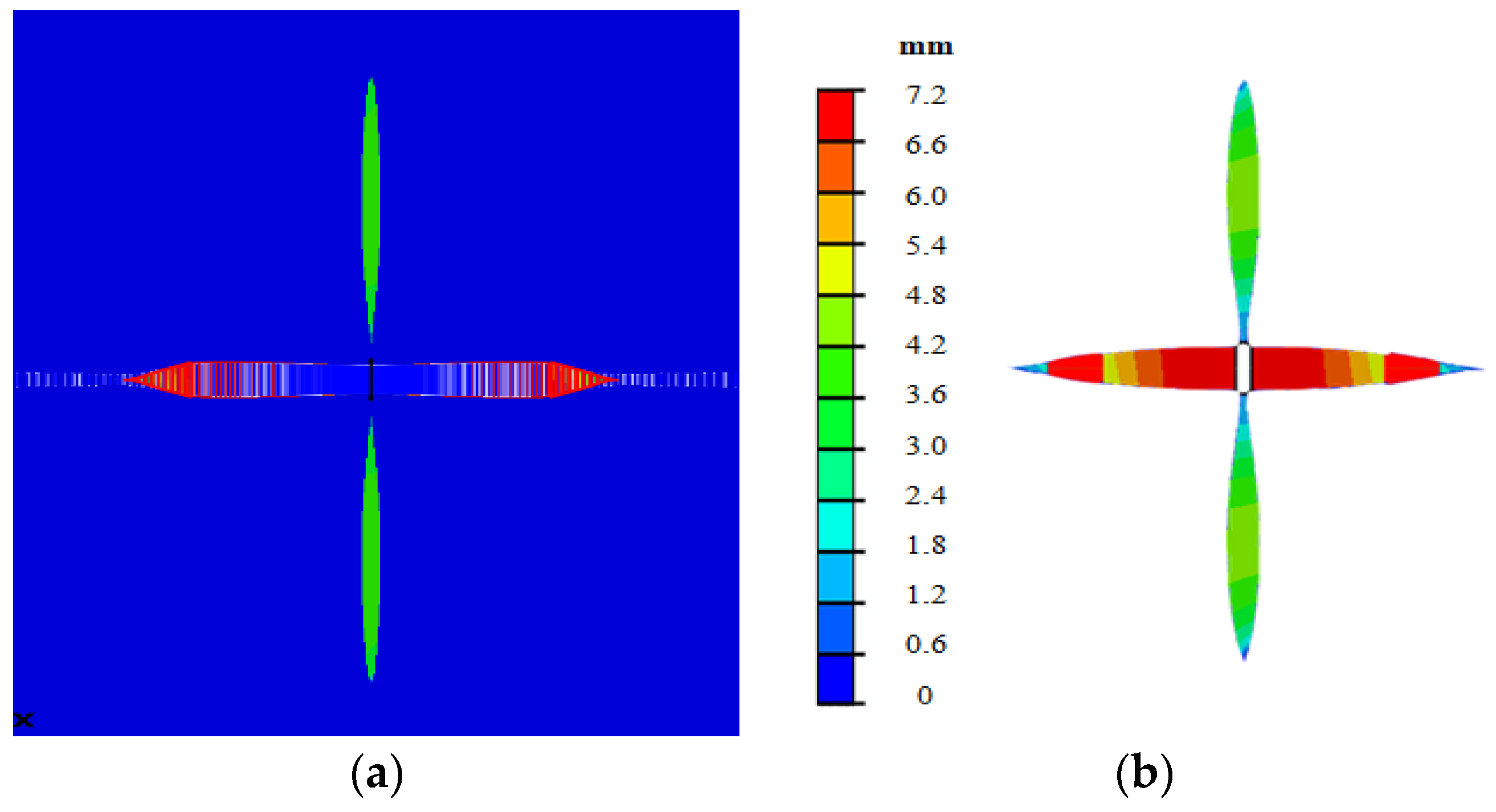
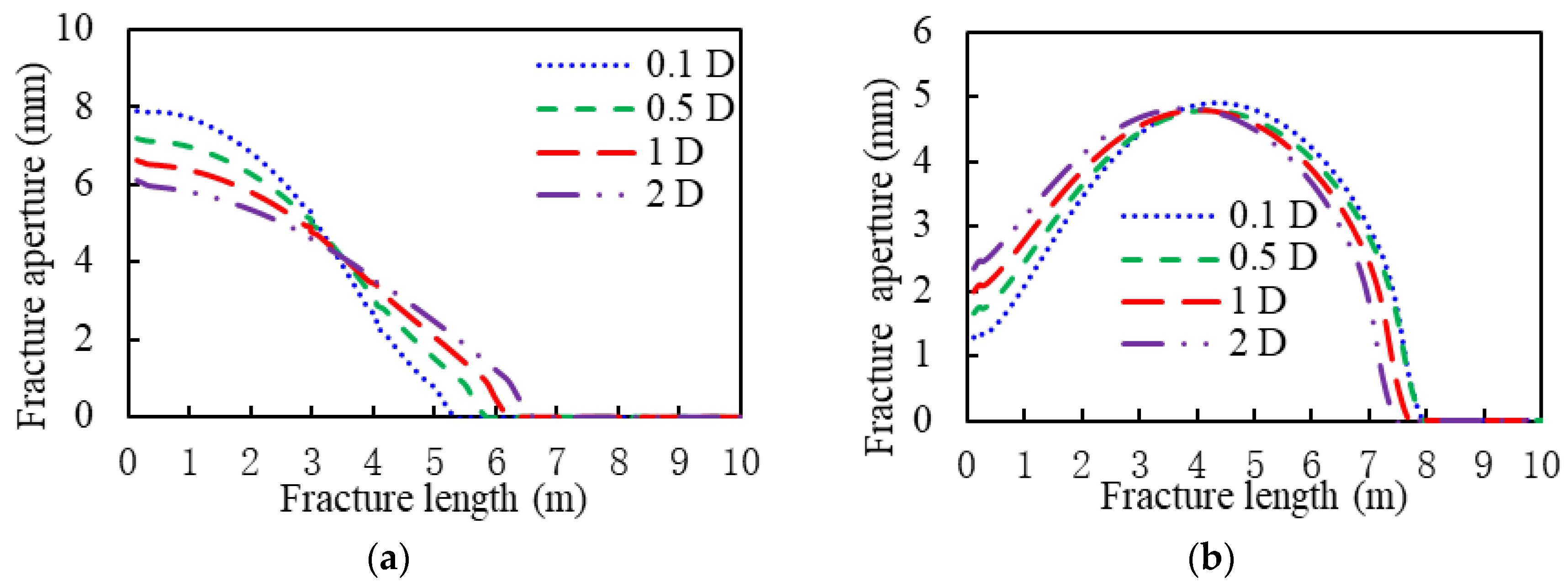
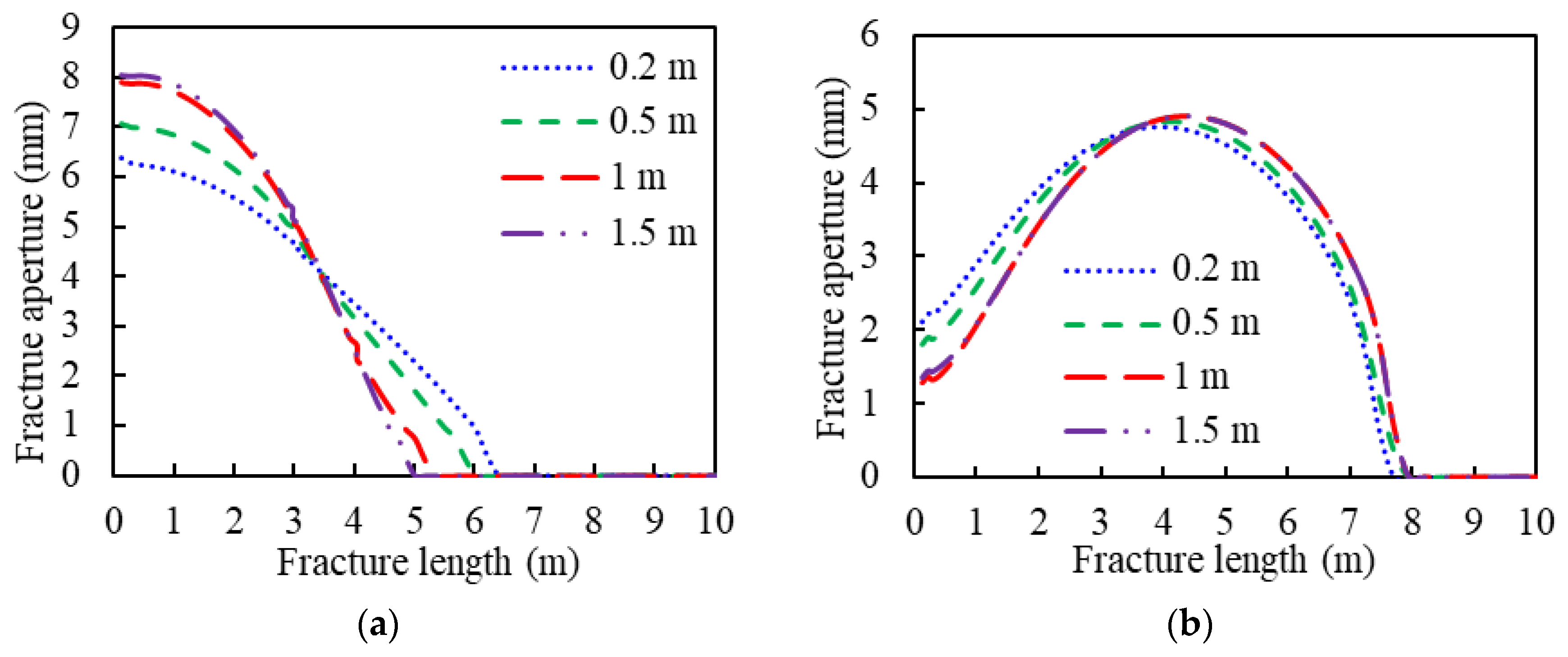
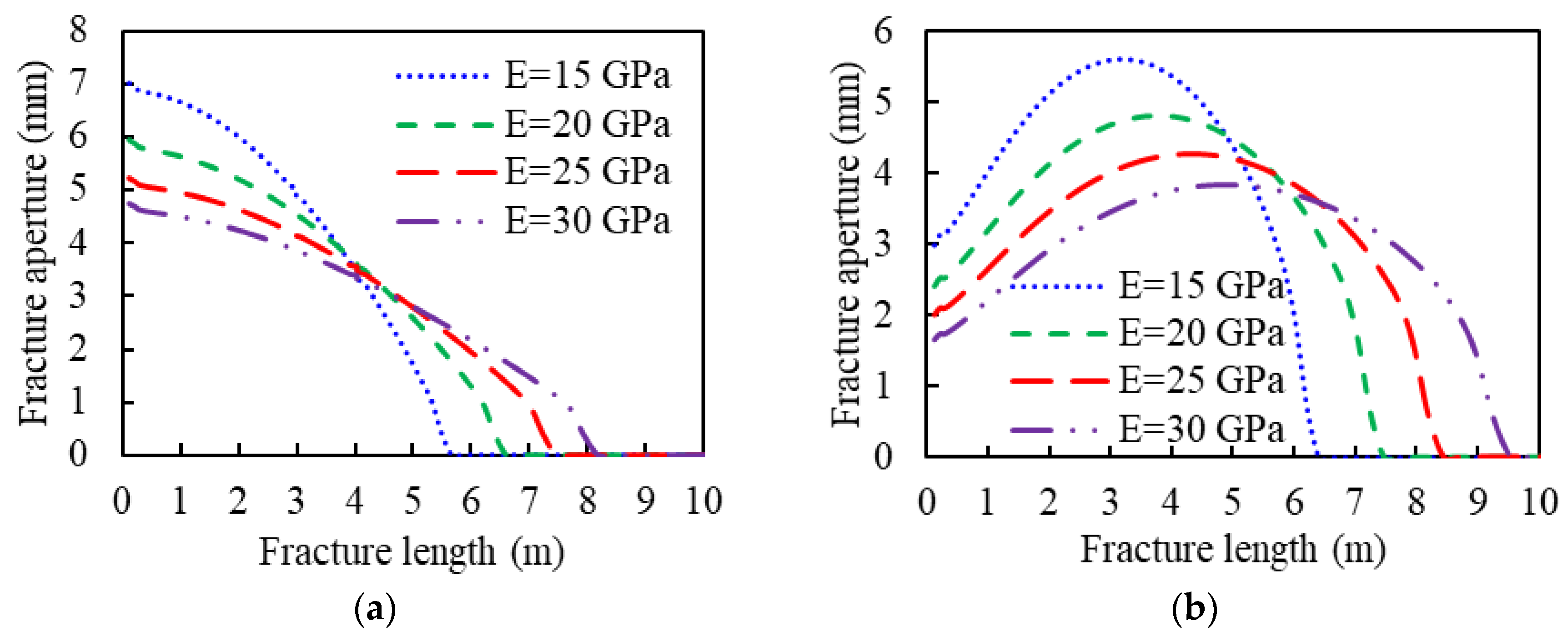


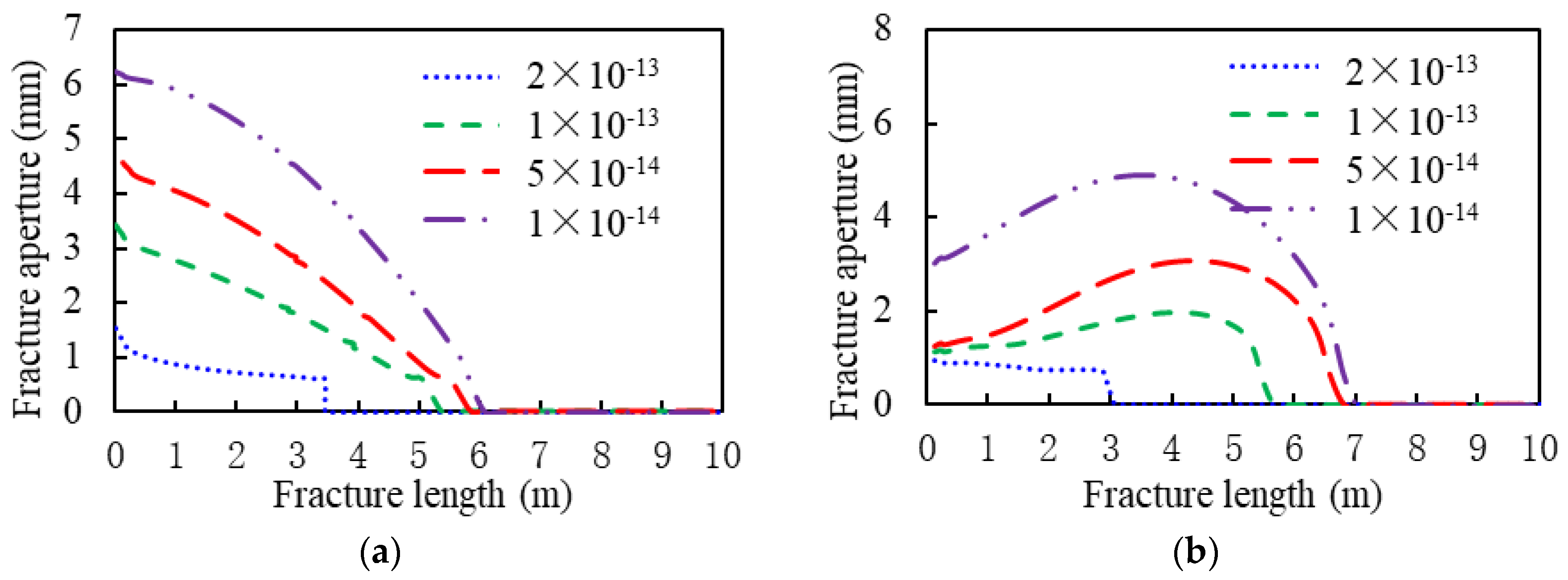

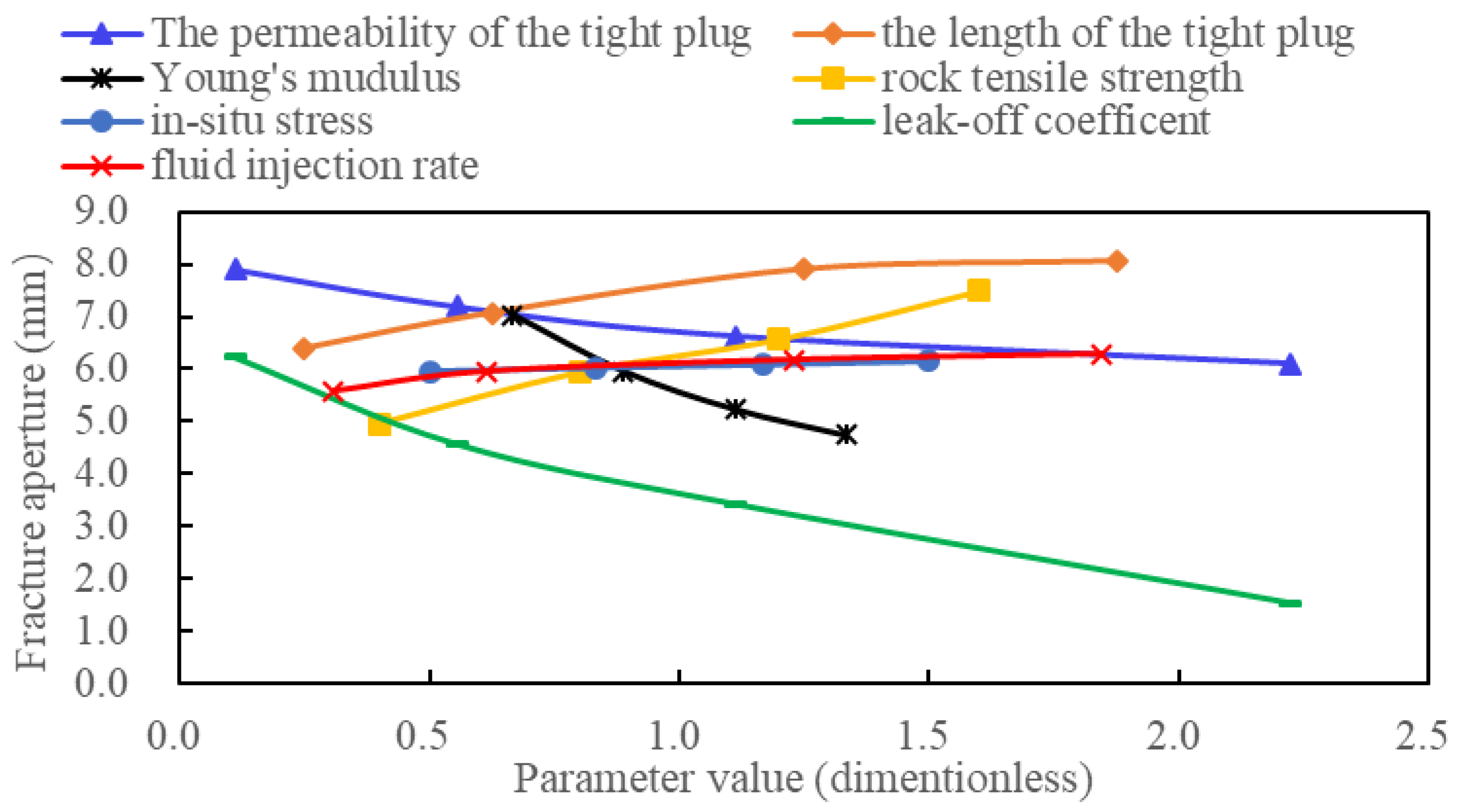
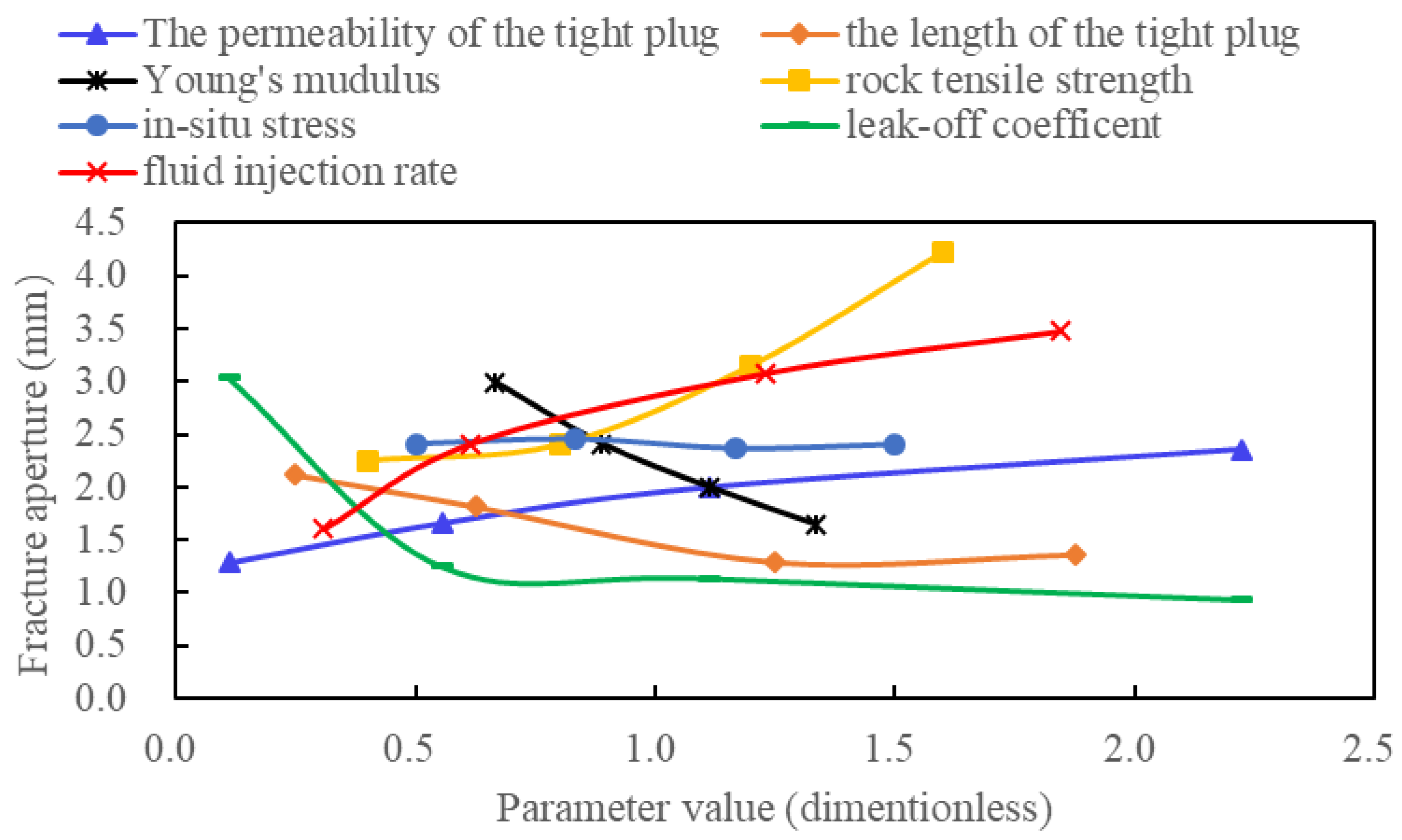
| Category | Parameter | Value |
|---|---|---|
| Rock Property | Young’s modulus, E (GPa) | 25 |
| Poisson’s ratio, v | 0.22 | |
| Permeability, k (mD) | 0.58 | |
| Fracture Property | Tensile strength of HF, σt (MPa) | 8 |
| Leak-off coefficient (m/s/Pa) | 1 × 10−14 | |
| Tight Plug Property | Permeability of the tight plug, (mD) | 500 |
| Length of the tight plug, (m) | 0.5 | |
| In Situ Stress | Minimum principle horizontal stress, σh (MPa) | 55 |
| Maximum principle horizontal stress, σH (MPa) | 60 | |
| Fluid Parameter | Fluid viscosity, μ/(Pa·s) | 0.1 |
| Injection rate, Q/(m3/min) | 4 | |
| Initial Condition | Initial pore pressure, po/(MPa) | 37 |
| Void ratio, Φ | 0.08 |
Disclaimer/Publisher’s Note: The statements, opinions and data contained in all publications are solely those of the individual author(s) and contributor(s) and not of MDPI and/or the editor(s). MDPI and/or the editor(s) disclaim responsibility for any injury to people or property resulting from any ideas, methods, instructions or products referred to in the content. |
© 2023 by the authors. Licensee MDPI, Basel, Switzerland. This article is an open access article distributed under the terms and conditions of the Creative Commons Attribution (CC BY) license (https://creativecommons.org/licenses/by/4.0/).
Share and Cite
Wang, Y.; Sun, B.; Wang, T.; Hao, Z.; Wang, B. Quantitative Investigation of Fracture Apertures during Temporary Plugging and Diverting Fracturing. Sustainability 2023, 15, 14664. https://doi.org/10.3390/su152014664
Wang Y, Sun B, Wang T, Hao Z, Wang B. Quantitative Investigation of Fracture Apertures during Temporary Plugging and Diverting Fracturing. Sustainability. 2023; 15(20):14664. https://doi.org/10.3390/su152014664
Chicago/Turabian StyleWang, Yubin, Baojiang Sun, Tianju Wang, Zhiwei Hao, and Bo Wang. 2023. "Quantitative Investigation of Fracture Apertures during Temporary Plugging and Diverting Fracturing" Sustainability 15, no. 20: 14664. https://doi.org/10.3390/su152014664





